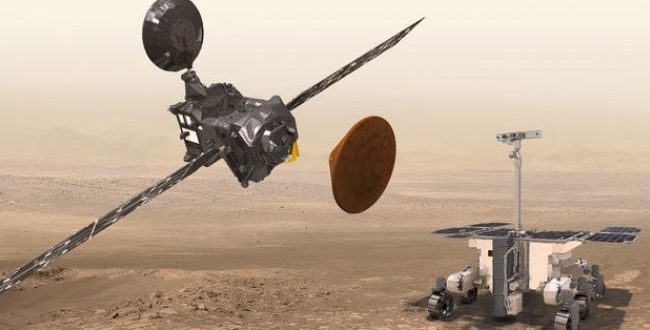The landing module of a European-Russian spacecraft detached from its satellite on Sunday and began its descent on Mars.
The 600-kilogram landing module, named Schiaparelli, is expected to reach the surface of the desert planet on Wednesday, the European Space Agency (ESA) said on its website.
The lander is laden with equipment that should provide a window on the local environment, taking measurements on wind speed and direction, humidity, pressure, temperature, electric fields and geology. But Schiaperelli’s biggest task will be to test new descent and landing technologies in preparation for a second, even more important, related mission. If all goes according to plan, this would see a much bigger vehicle – the ExoMars rover – landing on Mars in 2020 for a far more in-depth study of the planet.
‘We are anxious to get excellent results’
“I often compare these two missions to high school and university. You need to pass the final exams for the first in order to be able to study and graduate on the second.
“Hence we are anxious to get excellent results with this first mission,” Jorge Vago, project scientist of the European Space Agency’s ExoMars project, told i.
“And that is exactly how I feel now. As if I were sitting for my high school finals, looking forward to a big party – hopefully – but with an eye on the next big step that will be more challenging and ambitious in scope,” Vago added.
The first mission will also attempt to put the Trace Gas Orbiter spacecraft, the mothership which carried the Schiaparelli to Mars, into orbit around the planet.
‘Immense science potential’
“ExoMars is a programme with immense science potential. The first mission, by studying atmospheric methane, may be able to establish if methane is the byproduct of micro-organism activity in the Martian subsurface – who knows?” said Vago, holding out hope that phase one of the project could offer valuable clues about the existence of life on Mars.
“The second mission directly targets the possiblity that Mars may have harboured life early on – about 4 billion years ago – when conditions on the Martian surface were almost identical to those on Earth when life appeared on our planet,” he added.
Agencies/Canadajournal
 Canada Journal – News of the World Articles and videos to bring you the biggest Canadian news stories from across the country every day
Canada Journal – News of the World Articles and videos to bring you the biggest Canadian news stories from across the country every day



